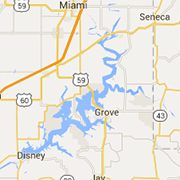Safe Fun in the Sun

- You should always avoid swallowing or getting water in your mouth.
- Using swim goggles, ear and nose plugs may also be helpful.
- After swimming, dry your ears well with a towel/washcloth, tilting each ear down to help water drip out of the ear canal. This can help prevent swimmer’s ear
Boat Rafting 101

One of the great pleasures of boating at the lake is joining your friends and making new ones on their boats to share the fun times with. There are a number of events held at the lake that attract a multitude of boaters that will typically Raft their boats together. But there are a number of things that can go wrong when rafting together. It’s not just the physical danger of the contact of the boats tied together that can be problematic, but the obscure danger of being in an environment where your guard may be down while enjoying the relaxation of the moment.
Although rafting together with other boats can give you temporary “safe harbor”, you must constantly be watchful on the dock formed by you and your neighbors to ensure that tragedy doesn’t strike. Here are some tips to ensure you don't get blindsided by an unfortunate rafting mistake:
- Before you anchor down, point your bow into the wind to help your vessel ride out the wind, waves and wakes that can relocate even the best of rafts.
- Too many fenders are better than not enough! Protect your vessel and others where they will be in contact, and be ready for changing weather and water conditions.
- Be prepared to drop anchor by having enough anchor line for the depth of the area you plan to take refuge. In fact, you should plan to set 5-7 times more anchor line than the depth where you will set anchor. Always drop anchor on all vessels, not just the largest few. Every boat is required to have an anchor, so use them to reduce the risk of the raft breaking loose. This is best done by dropping anchor and backing to where you want to be tied together to ensure your anchor gets properly set.
- Leave a space of at least 50 foot wide between you and the boats in front and behind, as well as an “isle” on each side of your raft, not just for the courtesy of swimmers and other boaters passing through, but to ensure emergency responders can maneuver around the rafted vessels in an emergency. This includes the swimming pads you put out behind your boats!
- Set the largest boat at anchor first. This boat will serve as the “anchor” for the rest of the party. This boat MUST be placed strategically in a place that will NOT be affected by wind, waves, current and/or a current shift.
- Place large boats together in the center, and smaller boats to the outside of the 'wings.' Place as many anchors as possible, and ensure that each boat is setting an anchor first, THEN powering back to raft up with the other boats. Ideally, each of the boat anchors will extend perpendicularly to the line of boats (as opposed to set at sloppy angles from the bows).
- Although lots of care, attention, scope, and multiple anchors will be a great assistance to holding your collective ground, there still is a finite number of boats that can safely raft together. Realistically, a line of 5 or 6 is capacity; 7 is overdoing it most of the time.
- You need to have a swing plan, because on an especially windy day, there is no doubt the raft will break loose and begin drifting its way towards other boats and anchor lines. This can be a difficult maneuver to accomplish, since you'll have multiple anchors out front, and you will have to work in concert with your neighbors. You can end up floating over the anchors and getting all sorts of tangled up. This can only be done if you work together to pull up the anchors, and use one or multiple motors to maneuver the group and reset the anchors.
- Have an exit strategy. If another captain seems careless about any of these procedures, consider whether you want that person rafting up with you. If you start to drift on your anchor, or have another emergency situation, you need to have extreme confidence that your rafting team can handle that situation swiftly and accurately, without panic or potentially deadly mistakes. Plan ahead of time, a way that your fellow captains will handle a drifting situation if it arises (drifting is probably the number one concern among rafters).
- Beware of wakes or large waves. Rogue wakes can rock an armada of boats harder than you can imagine. You'll find yourself at risk of losing fiberglass, limbs, fenders and lines this way. Again, safety and proper setting is a must. NEVER put your limbs in between any boats, no matter how calm the water is at that point. Also, use LOTS of fenders and place them strategically between the boats at obvious rub points. If you've set your lines properly, your boats will connect just as they would at a fixed dock.
- Coil lines properly so they stay out of the way of people climbing in, on, or around the boats. Tripping up in a line could prove fatal. In fact, all kinds of injuries can occur when people are hopping boats, hanging out on slick swim platforms, and jumping off bows. Those things are fun - enjoy them - but do use caution and advise everyone to do the same. Falling off a slippery swim platform is not fun, and it's completely avoidable.
- Check behind your stern before you start your engine! All too often we are hurried or careless and start our engines before checking for prop clearance. ALWAYS check to ensure your stern and prop are clear before you fire up the motor.
As with all things boating, vigilance and forward-thinking will make a day on the water fun and safe. Although this seems like a lot of work, you'll soondevelop a routine and accomplish all of these tasks without much thought at all.
Rush for Brush on Hudson

GRDA teamed up with several partners last week to build and place fish habitats on Lake Hudson. Personnel from our Eco department had a great time building and deploying fish structures on Lake Hudson with the Oklahoma Department of Wildlife Conservation (ODWC) and Thunderbird Youth Academy.
Twenty-seven Thunderbird Challenge Camp youth joined the project to help build and deploy 450 centipede-like fish habitat structures to create underwater structures for fish on Hudson Lake that were placed in the areas marked on the above photo near the Highway 20 bridge.
The Grand River Dam Authority sought help from the group for the community project. Friday’s effort, one of many more to come, concentrated sinking the hundreds of plastic trees in areas where people can fish from the shoreline near the Oklahoma 20 Bridge at Salina.

Boating Tips from the GLSPS

Sound producing devices are required by law to be on your boat. This may be a horn or whistle. For small boats and personal watercraft, a plastic whistle is the simplest way to satisfy the requirement. If you request a vessel safety check from the Power Squadron or the Coast Guard Auxiliary you will be required to have a horn or whistle that can produce a 4 second sound audible for a ½ mile. Sound signals with a horn or whistle can be very helpful for safe boating. One of the most important is the danger signal. When in doubt whether sufficient action is being taken by the other boater to avoid a collision, the boater should sound five short and rapid blasts with a horn or whistle. Another signal that can be helpful is when overtaking another boat. One short blast indicates that you are going to overtake the boat leaving him on your port side. Two short blasts indicate that you are going to leave him on your starboard side. The other boat should respond by giving the same signal indicating that he is in agreement.
To learn more about boats and boating, the United States Power Squadrons offers many courses such as seamanship, navigation, marine mechanics and marine electronics. For more information visit our website at: www.grandlakeusps.com or on Face Book at GLSPS.
Do you have a Special Event Planned? PLEASE let us know about your lake or river events so we can provide the resources you may need to make it a positive experience!
2017 Lake Events Schedule
- Splash Bash: June 17, Ketchum Cove, Hammerhead Marina
- Grand Lake Fireworks: July 1, Disney
- Horse Creek Resort Fireworks: July 1, Horse Creek
- 50th Annual Huckleberry Festival Fireworks Display: July 2, Jay
- Duck Creek Fireworks: July 3, Duck Creek
- Salina Independence Day Fireworks: July 3, Salina on Lake Hudson
- SDBA Drag Boat Races: July 8 & 9, Wolf Creek Ramp
- GLOC Charity Troop Tour: July 14, Grand Lake
- GLOC Performance Boat Challenge: July 15 & 16, Sailboat Bridge
- Aquapalooza: July 15, Horse Creek
- Bobber Drop: July 22, north Grand Lake
- Thunder on Wolf Creek: August 18, 19 & 20, Wolf Creek Ramp






